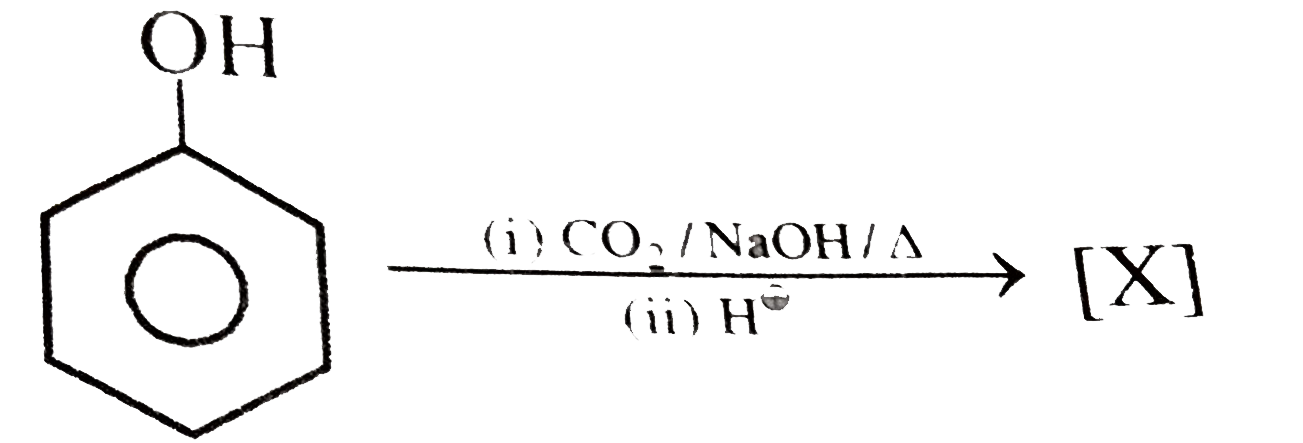In the given reaction (major product) [X] will be
The correct Answer is:B
To solve the reaction C6H5−CH2−Br+AgCN→X, we will follow these steps:
Step 1: Identify the Reactants
The reactants in this reaction are:
- Benzyl bromide (C6H5−CH2−Br)
- Silver cyanide (AgCN)
Step 2: Understand the Reaction Mechanism
In this reaction, silver cyanide acts as a nucleophile. The bromine atom in benzyl bromide is a good leaving group. When silver cyanide is introduced, it will replace the bromine atom.
Step 3: Nucleophilic Substitution
The nucleophilic substitution occurs as follows:
- The cyanide ion (CN−) from AgCN attacks the carbon atom that is bonded to the bromine in benzyl bromide.
- As a result, the bromine atom leaves, and the cyanide group attaches to the benzyl carbon.
Step 4: Forming the Product
The product formed from this reaction is benzyl cyanide (C6H5−CH2−CN), but since the question specifies the major product, we need to consider the isocyanide formation as well.
Step 5: Final Product
The major product of this reaction is isocyanide, which is represented as:
C6H5−CH2−NC
This is because the reaction with AgCN can lead to the formation of isocyanide due to the rearrangement of the cyanide group.
Conclusion
Thus, the major product X is C6H5−CH2−NC.
Answer
The major product X is C6H5−CH2−NC.
---
The reactants in this reaction are:
- Benzyl bromide (C6H5−CH2−Br)
- Silver cyanide (AgCN)
In this reaction, silver cyanide acts as a nucleophile. The bromine atom in benzyl bromide is a good leaving group. When silver cyanide is introduced, it will replace the bromine atom.
The nucleophilic substitution occurs as follows:
- The cyanide ion (CN−) from AgCN attacks the carbon atom that is bonded to the bromine in benzyl bromide.
- As a result, the bromine atom leaves, and the cyanide group attaches to the benzyl carbon.
The product formed from this reaction is benzyl cyanide (C6H5−CH2−CN), but since the question specifies the major product, we need to consider the isocyanide formation as well.
The major product of this reaction is isocyanide, which is represented as:
C6H5−CH2−NC
This is because the reaction with AgCN can lead to the formation of isocyanide due to the rearrangement of the cyanide group.
Thus, the major product X is C6H5−CH2−NC.
The major product X is C6H5−CH2−NC.
Similar Questions
Knowledge Check
In the given reaction sequence C6H5−CH2−NH2CHCl3/Alc.KOH−−−−−−−−−−−−−→Δ[X]H2O/NaOH−−−−−−−→[Y].
[Y] will be:AC6H5−CNBC6H5NCCC6H5−CH2−NH2DC6H5−CH2OHIn the given reaction CH3−CH2−NH−CH2−CH2−Cl(i)CH3I(excess)−−−−−−−−−−−−−→(ii)AgOH/Δ[X] is the major product, [X] will be:
ACH2=CH2BCH2=CHCIC1:1 ratio of (a) and (b)DCH3−CH2−CI
In the given reaction
CH3−CH| CH3−CH=CH2+HCl→[X]
Major product [X] will be
View SolutionIn the given reaction :

Major product [X] is :
View SolutionIn the given reaction [C6H5−CH2−CH2−⊕N(CH3)2−CH2−CH3]ΘOHΔ−−→ (X) as major product will be
View SolutionIn the given reaction
C6H5−O−CH2−CH3ExcessHI/Δ−−−−−−−−→[X]+[Y]
[X] and [Y] will respectively be:
View SolutionC6H5CHO+CH3COOCOCH3CH3COONa−−−−−−−→Δ products
If one product of above reaction is C6H5−CH=CH−COOH the other organic product (side product) is
View SolutionWhat are the major products formed in the following reactions ?
(i) C6H5−CH2−CH=CH2+HBr→
(ii)
View Solution
